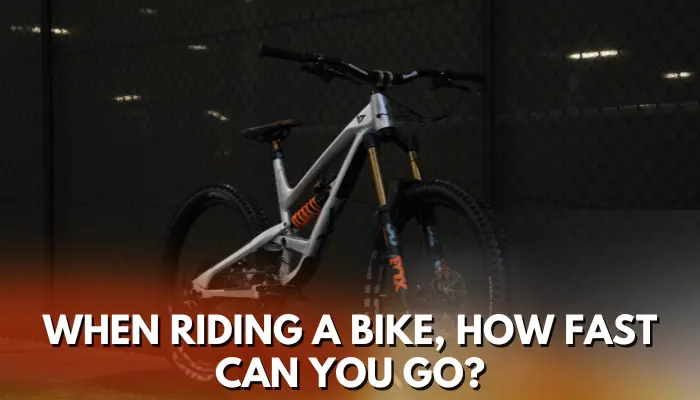When Riding a Bike, How Fast Can You Go?

Have you ever wondered how quickly you can ride a bike? Numerous things influence how fast you cycle. Your cycling speed can be significantly influenced by your skill level, the dimensions and condition of your bicycle, and the surrounding environment.
Table of Contents
Short Answer
Well, you might be thinking, how fast can you go on a bike in general? Your top speed will often be around 30 miles per hour. Professionals may travel at a top speed of roughly 45 miles per hour. It is best to purchase a bike made for extreme speeds if you intend to go any faster.
Additionally, you should be aware that there are numerous subcategories in the riding sector. To make sure that you bike at your top pace, keep these things in mind before you get on the bike.
How Fast Can You Go On A Bike?
The best option for individuals who like fast-paced activities is cycling. However, have you ever thought about how quickly you can ride on your bike? Hitting your highest speed is a thrilling endeavor, regardless of whether you’re doing it in a hurry to blow off steam or as part of your training for a major race.
Your degree of fitness, skill, and bike quality all play a role in how quickly you can ride a bike. Indoor cyclists can attain speeds of 60 to 70 miles per hour, whereas competitive outside cyclists can reach up to 45 miles per hour. The average pedaling speed of an inexperienced cyclist is 13 miles per hour. However, this speed can be increased to 20 or 30 miles per hour.
Factors that may have an impact on bike speed
- The weight
Not only are we relating to your weight here, but also the size of your bike. One’s weight is determined by gravity. The more weight you have, the more gravity is pulling you down and opposing you as you go forward. You may have observed that due to the added weight of backrests, water bottles, and luggage racks, professional road cyclists avoid using them. You can choose lighter bikes if you’d like.
- Wheels and tires
You move more quickly the larger the tire. The more quickly you ride, the more air resistance there is pushing back against your bike, slowing you down. However, a larger tire can overcome wind resistance more effectively than a smaller tire. High-end racing bicycles typically have larger tires placed on their rims than regular road bikes because they offer an edge over a more compact tire.
Different tire types exhibit varied behaviors depending on the terrain they’re mounted on and how they’re inflated. For instance, a tire with a low-key approach can grip the ground more effectively, making it better suited for uneven or rugged terrain and less suited for seamless or flat terrain. The same principle governs the wheel’s speed. You move more quickly the larger and faster the wheel. While regular bikes typically have medium-sized wheels, professional bicycles have extremely light wheels.
- Suspension system
Suspension systems work like a spring to absorb the force of bumps and lessen their ferocity, thanks to their soft suspension cams. Lightening the burden on your muscles, allows you to move more quickly. In other words, your muscles don’t have to work as diligently because the force of the hit is lessened.
Along with road bikes, expensive racing bicycles have suspension systems. Most road bikes lack suspension systems, and the only people who utilize them to boost speed are professional road cyclists.
- The strength
Leg and thigh strength in the muscles are two of the key factors affecting cycling speed. The stronger you are, the faster you cycle. Over time, cycling becomes a routine part of your life, requiring a smaller effort for the identical amount of labor.
A cyclist’s endurance has an impact on their speed. Your leg and thigh muscle tissue need oxygen, fatty acids, as well as glucose to provide the energy required for cycling. Your muscles will use alternative energy sources if they run out of oxygen. Therefore, improving your stamina is essential if you want to expand the oxygen-holding capacity of your lungs.
- Gearing systems
Picking a fast bike involves taking into account gearing schemes like internal and simple gears. By automatically shifting gears, these gearing systems enable you to pedal at greater speeds with less effort, so you do not need to be concerned about it. High-end racing bicycles typically feature internal gears, while older normal bikes typically have simply two or three exterior gears.
- Resistance
You can slow down due to friction, resistance, or drag. On a bicycle, resistance factors like air pressure and wind speed prevent you from going as fast as you can.
It’s crucial to think about your bicycle attitude as well. Competitive cyclists lower themselves to the ground when riding their bikes to reduce their body image and achieve a more sleek form.
Their riding stance enables air to pass through over their curving bodies rather than smacking them in the chest. The choice of clothing and a helmet is also crucial. Even though wearing a loose or roomy outfit may be more comfortable, the excess cloth can make you slower and generate resistance.
How Can You Increase Your Cycling Speed?
Here are some suggestions on how to increase your bike speed.
- Take into account high-intensity interval training, which emphasizes the development of lower body strength and stamina.
- To aid in your strength and endurance training, invest in a high-quality cadence meter and heart monitor.
- By engaging in regular exercise and consuming a well-balanced diet, try to reduce your weight.
- Look at what you can take off of your bicycle to lighten it. If you’re serious about cycling competition and have the money, you might want to trade in your road cycle for a high-performance crushing machine.
- Learn the proper speed biking position.
- To minimize drag and increase speed, don’t wear anything but the proper clothing and safety gear.
Speed of Professional Cyclists
Impressive speeds can be reached by professional cyclists, especially during competitions and time trials. The actual speed fluctuates based on several variables, including the terrain, the weather, the design of the course, and the riders’ level of fitness. Here is some broad information on the top speeds that professional cyclists can reach.
Flat Ground:
Professional cyclists can ride at an average speed of 25 to 31 miles per hour (40 to 50 kilometers per hour) on flat terrain throughout a race. However, speeds may go over 60 km/h (37 mph) for brief periods during sprint ends or in particular time trial events.
Uphill Climbs:
Speeds will inevitably drop on mountainous or steep stages of a race because of the greater resistance. Professional climbers are still tremendously quick, though. During difficult climbs in mountain stages, they can maintain speeds of roughly 20 to 30 kilometers per hour (12 to 19 miles per hour).
Descending:
Professional cyclists can travel at amazing speeds during downhill segments. Professional riders may effortlessly approach 100 kilometers per hour (62 mph) on lengthy descents with highways that are open and in favorable conditions. Certain riders have been reported to attain even higher speeds in certain circumstances.
Time trials:
These are solitary competitions in which the clock is the only factor, usually held on flat and rolling terrain. Bicyclists can reach incredibly high speeds in these competitions. A professional time trialist can cover a distance of 40 kilometers (25 miles) while maintaining a typical speed of 50 to 55 kilometers per hour (31 to 34 miles per hour).
It’s crucial to keep in mind that these rates are merely estimations and may change based on the particulars. Professional cyclists may reach greater speeds with fewer efforts thanks to drafting, which involves riding next in line to another rider to lessen wind resistance.
FAQs
Is 30 km/h on a bike fast?
You’ll start to ride more quickly and cycle at a greater average pace once you start riding frequently. Expert riders are predicted to travel at an average pace of between 30 and 35 km/h.
Is cycling 100 kilometers simple?
Even though riding 100km is difficult, it is incredibly doable. Although it could take more for some, most semi-active people should be able to complete a 100-kilometer bike ride in a single day. It’s primarily a struggle of willpower. And when you’re done, you will have the feeling of being a total badass.
Is it acceptable to bicycle every day?
You can ward off serious illnesses like obesity, cardiovascular disease, cancer, mental disorders, diabetes, and arthritis by engaging in regular physical activity. One of the best methods to lower your risk of health issues linked to a sedentary lifestyle is to ride your bicycle frequently.
Does cycling result in muscular growth?
Cycling targets cardiovascular endurance while constructing the muscular structure from a pace and endurance perspective. Numerous muscles in the body are worked and toned by cycling. The muscles of the arms as well as the core, get a tremendous workout in addition to the muscles in the lower body, which are undoubtedly the main muscles addressed.
Can cycling make you taller?
Regrettably, no. Cycling raises hormonal levels in the circulatory system, including the growth hormone, as does any aerobic exercise. However, adults who have previously gone through puberty are completely unaffected by this.
Is riding bikes safer?
Given that both drivers and bikers face their own set of risks, driving a car isn’t necessarily better than riding a bike. Bicyclists are more likely than car drivers to suffer fatalities and serious injuries in collisions, along with motorcyclists.
Does cycling harm knees?
Osteoarthritis can only be caused by riding under extreme circumstances, such as competitive cycling, which combines standing and quick pedaling. This type of cycling puts a lot of pressure on the cartilage and knee joint. A badly wounded knee will result from weak muscles and a weak knee joint.
Conclusion:
For many cyclists, reaching top speed is a significant and thrilling marker. The speed you might fairly hope to accomplish is heavily influenced by how you practice and how long you’ve been exercising. Another element to take into account when choosing your objective velocity is the varying demands that different training environments place on your body.
Now you know how fast you can go on a bike. Regardless of the equipment you have, you should be able to reach high speeds of 20 to 30 mph with some effort and training. If you find that exciting, you could keep going until you reach a respectable 45 mph.
